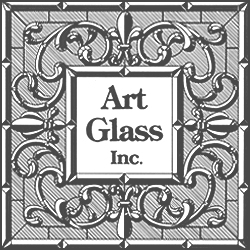
1978 - 2003
Ray Gregory, Art Glass, stained glass, Norfolk, Virginia
 2.jpg)
Glass cutting and stained glass assembly areas in the warehouse studio
In 1978, at the age of 32, I decided to turn my stained glass hobby into a business. I hadn't been one of those lucky kids who knew early on just what he wanted to do in life, and therefore what to aim myself at and prepare for. After military service and college, I held a number of jobs, blue collar as well as white, in my hometown of Norfolk, Virginia. Happily I picked up several useful skills along the way (plumbing, carpentry, construction, electrical and electronics work, metal working, lab work, office work, even some interviewing and teaching experience). The most important thing I finally realized was that self-employment, working for myself, not having to answer to anyone but myself (and, of course, my customers), was the only way I could be satisfied with working.
While I'd concentrated on sciences in college (mainly psychology and physics), I realized my fascination with science had been as fickle as it was romantic. I should have realized all along that my natural visuality and fondness for drawing and, of course, playing with colors, plus my knack for making things with my hands, would win out in determining a vocation that fit me.
For the first couple of years I plied my stained glass window trade out of my home workshop, mainly doing small residential commissions. For a while during this time, I informally partnered with Jerry Brannin, whom I'd known during my college days in the "counter-culture" Sixties and who I'd heard had opened a small stained glass shop on Colley Avenue in the Ghent section of Norfolk. Jerry had given his business the unlikely name Myrddin Emrys Atelier (he wasn't that far removed from his hippy days and may have fancied himself a latterday Merlin), but he would later change it to American Art and Leaded Glass. At any rate, Jerry and I found ourselves in considerable disagreement over how to run a successful business, so our collaboration soon ended.

My very first commercial commission, stained glass hangings for a Ghent ice cream shop
I then rented my own retail space, the ground floor of a storefront building on Freemason Street in downtown Norfolk, and hung out a sign reading Art Glass Resplendent (a conceit drawn from my initials, ARG). Sometime after incorporating, I would shorten the name of the business to Art Glass, Inc. I remember Richard Pike, who at the time owned most of the buildings on College Place (between Boush and Granby Streets in downtown Norfolk) and ran his antique business out of one of them, asking me if I knew what I was doing and what my "business plan" was. Business plan? What's that? According to Richard, there weren't more than maybe seventy people in Norfolk who would want to buy stained glass, and then what would I do? And he was right, at least about me not having much of a plan, because I was indeed just blindly forging ahead with something I wanted to do, and mainly because I enjoyed doing it. But Richard hadn't taken into account all the religious congregations, the restaurants, even the military.
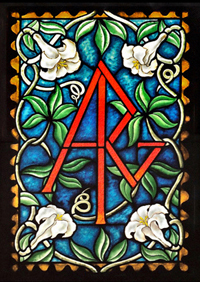
ARG Monogram in attic window of the Tidewater Drive location
In the first couple of years, in the downtown location, I got my first church window commissions and even a restoration job at the Norfolk Naval Base — fire damage to the main Protestant Chapel's large central altar window (approx. 15 feet tall), which included replacing the window's arched wood frame as well as the damaged stained glass panels. This would turn out to be the first of many jobs my company would do for the Navy. Able builder Chuck Chamness, whom I'd recently met, was an invaluable help in accomplishing the chapel repair work, as he would be with many jobs to come. Chuck also introduced me to Russell Harris, who would help off and on with many things. Captain George Boyd, the Naval Base's head chaplain at the time, would remember my work at the chapel many years later and commission me to make stained glass windows for the church where he was serving as pastor after his retirement from the Navy.
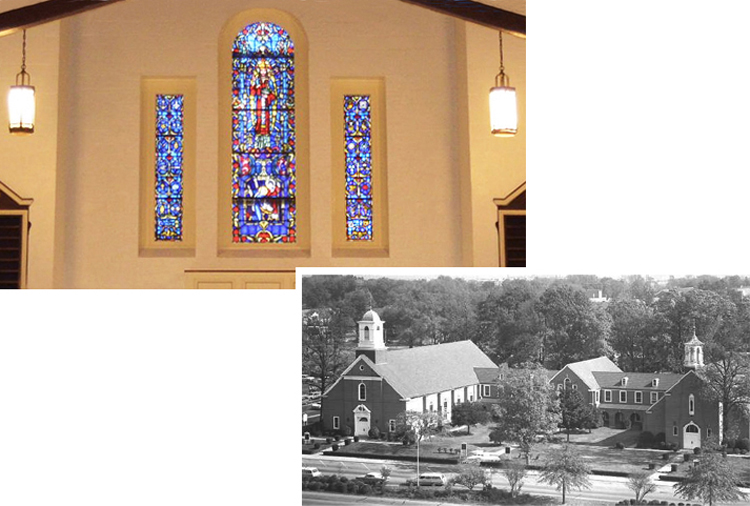
Main Chapel Complex, Norfolk Naval Base, first big stained glass repair job
It was at the downtown location that I added a sandblasting unit to the studio for doing etched glass, and soon afterward the Madison Hotel gave me my first commercial etched glass commission, glass dividers for its new lobby. I also read up on glass beveling by hand and put together the equipment needed for that. For several years in the beginning, I always went to the Stockley Gardens Arts Festial in Ghent to promote the business, and I typically got a handful of residential commissions from it. I would also produce a bunch of small beveled hanging pieces and sell two to three dozen of them per show, usually sell two or three larger pieces too. Mayor Henry McCoy got me to make 50 small stylized stained glass medallions of the Seal of the City of Virginia Beach for him to present to dignitaries visiting his office.
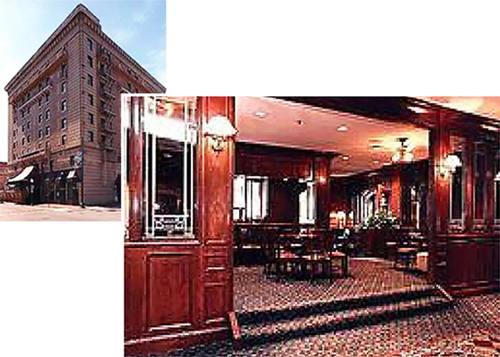
The Madison Hotel, first commercial etched glass job
But one morning in 1981, around 6 a.m., I got an urgent phone call from the Norfolk Fire Department. The building my business was in was on fire! I raced to the scene to find a smoldering mess. There'd been apartments upstairs, and the fire inspectors determined that one of the tenants caught the building on fire when he fell asleep smoking, then the building collapsed into my space on the first floor. Two people upstairs lost their lives (incuding the one the fire inspectors figured started the fire, judging from where it originated). Fortunately — at least for me — I had insurance.
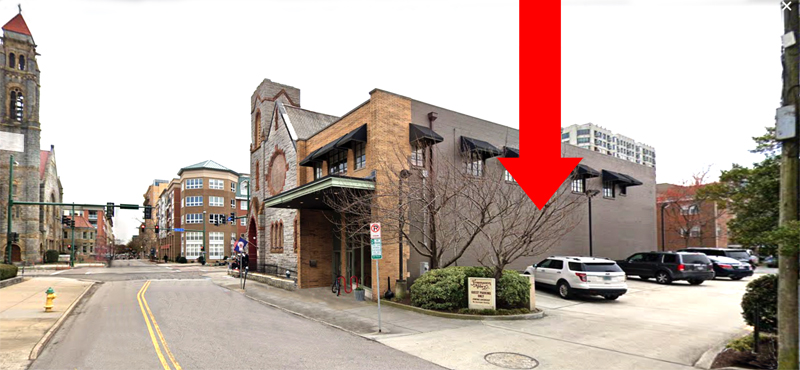
Location of the downtown shop/studio (now a parking lot), two doors west of Freemason Abbey, which was originally Second Presbyterian Church, but at the time was the local Order of Odd Fellows Lodge
I got the business up and running again in another rented space, then a year later I bought a building for the business on Tidewater Drive that many years earlier had housed a branch of the Norfolk Public Library. It was around this time that Reon Hillegass started bringing me all of Hillegass Lighting's damaged glass lampshades for fixing. And noted local architect John Paul Hanbury got me to do the etched glass for Reggie's British Pub at the then new Waterside in downtown Norfolk. During this time I also struck up a collaborative relationship with former Navy Seal Jack Macione. Jack was quite a go-getter and idea guy, and his company, Forth [sic] Dimension Design and Decor,
would subcontract to my company much of the restaurant and military work that it did, including those two crazy-big stained glass domes for Capt. George's Seafood's flagship restaurant on Laskin Road in Virginia Beach.

Stained glass domes at Capt. George's Seafood Restaurant, Virginia Beach
In 1986 I bought a spacious, though windowless (except for the office), warehouse building for the business near the Norfolk Industrial Park, but after installing several large skylights in its roof, the interior was flooded with natural daylight. Lyn Walker, who'd recently retired from the Navy and would be my most versitile worker, brought with him considerable workworking as well as artistic skills. He built a large patterning table and movable glass racks, and he and I built a number of work tables (for glass cutting and stained glass panel assembly), work benches, glass storage bins (which would hold several tons of variously colored and textured sheet glass), plus a walk-in abrasive blasting booth for carving and etching glass. I also assembled a large kiln for firing vitreous paints onto glass, added more motors, belts, and wheels for hand beveling glass, and installed a heavy-duty air compressor to power the abrasive blasting. Jeff Whelan joined the team part-time for two years or so while he was in grad school (he later became a college art professor). He brought with him the technical expertise for airbrush painting on glass that would become a staple of the church window production.
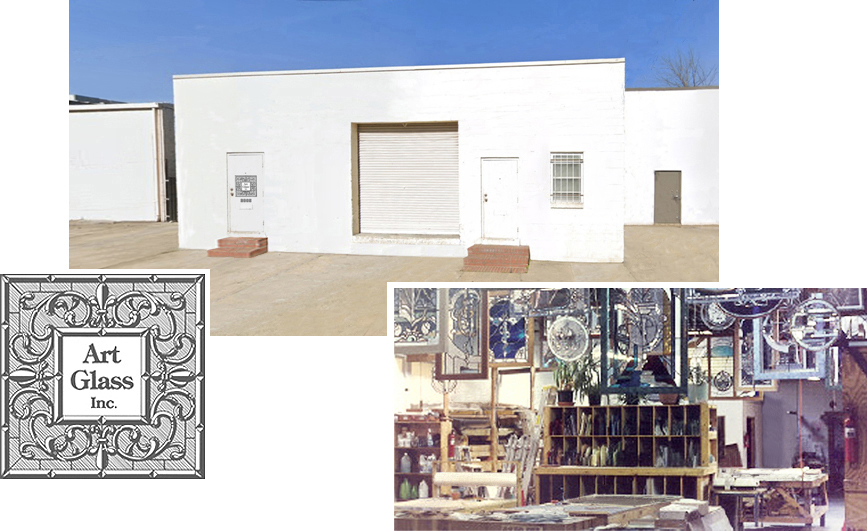
The near windowless, though full of skylights, warehouse/studio
It wasn't long after moving into the warehouse building that David Wilson, an internationally renowned architectural glass designer in New York, contacted me again. I had previously made the stained glass windows he'd designed for a Navy chapel. Now he commissioned Art Glass to do the "Wall of Light," about 2,500 square feet of stained glass for Washington Hebrew Congregation, D.C.'s largest synagague, the largest liturgical commission Art Glass would do.
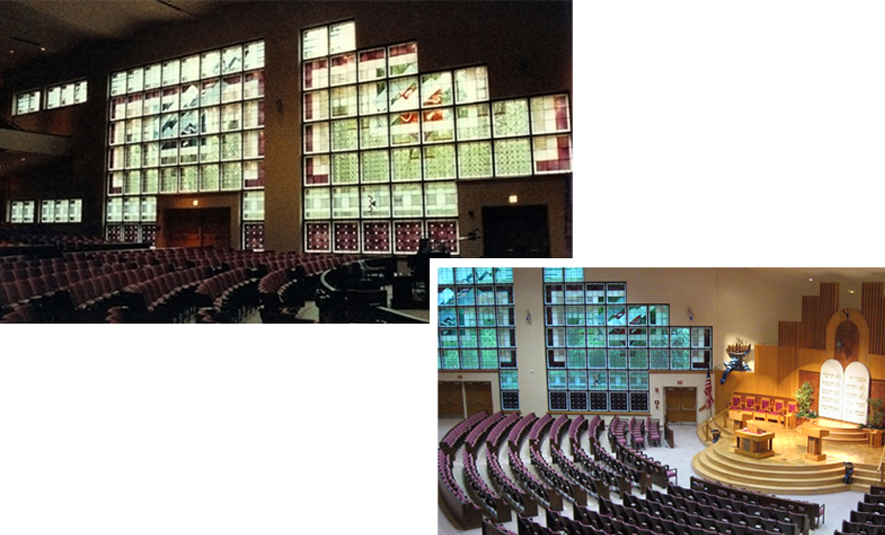
Sanctuary of Washington Hebrew Congregation
Between 1978 and 2003 Art Glass served well over a hundred (I think the number was about 135) religious congregations, either making new stained glass windows or restoring old ones. It also provided stained, beveled, and etched glass for many businesses and residences. During those years I often worked alone or with only one to three assistants, though for a while I had as many as eight employees, depending on what was cooking commission-wise and, of course, the vagaries of the economy. While I enjoyed the camaraderie of employees (we'd all go out to lunch together on Fridays, my treat), being the worldclass introspective introvert that I've always been, I preferred the contemplative, monastic-like times when it was just me, my hands, the glass, and a vision (that would sometimes attain a modicum of fulfillment). I never enjoyed supervising people, or trying to, but the most excruciting part of having employees was the times I had to lay people off because of a business slowdown. Having to meet a payroll could be trying at times too. But as far as customers went, I was lucky to have worked for so many churches and synagogues. I don't recall even one of them being late on a payment. Can't say the same for some of the restaurants.

Lots of stained glass repair work over the years
Near the end of 2003, after twenty-five years, I finally decided I'd had enough of the glass work. The one assistant I had that year, Lee Daniels, who was a whiz at beveling, had sometime before decided he would start his own business. So happily I didn't have to lay anyone off at the end. The idea of finding someone to buy the business never crossed my mind. The business was simply me. I found it satisfying, even cathartic, to sell off all the tools and equipment, supplies, and six-plus tons of assorted sheet glass that remained and scrap all the tables and benches and such, which I got quite a workout and thrill from doing myself, with sledgehammer and saw, enough to fill four 20-cubic-yard dumpsters! Then I had the interior freshly painted, returning the building to its pristine condition (actually much better than when I bought it with the new skylights and various other updates), then I sold it.
After a quarter century of bandaids on my fingers, I would discover digital art, a way to indulge my visually creative urges with nary a cut, plus illustrate my short stories. From 1978 until 2003, I had never used a computer for anything in the business, from design work to google searches. It had all been done with paper and pencil (or marking pen), and occasionally calling reference librarian John Parker for the answer to some arcane question. Back then the Internet, search engines, and the online experience had yet to become ubiquitous. Most of the old photos (taken with film) were lost over the years, but those on this website give a good idea of the varied work. These photos may even be all that remains of some of the glass, because already several of the restaurants that commissioned it, even some of the churches, are no longer around.
Speaking of the ephemeral nature of existence and memory, when I did an online search for Captain Boyd (the Norfolk Naval Base's head chaplain who'd been remarkably personable and who looked and sounde like John Wayne playing a Navy chaplain), all I could find was a brief mention about him (I think) during the Vietnam War. Many years ago (I don't remember just when), my wife and I stopped by his old church, and we were saddened to hear that he had died the year before, but I can't find his obituary online. And when I searched for Jack Macione, that gnomish but larger-than-life rascal who'd been a lieutentant commander with the Navy Seals, as well as a graduate of the Rhode Island School of Design, only a few brief mentions came up (a bawdy military tale, a Virginia Supreme Court decision, but nothing about his business, Forth Dimension Design and Decor or a subsequent business he started, Mr. Big). However, I did find a rather staid death notice from 2004. I'd rather imagine sly ole "Black Jack" Macione faked his demise and is still out there battling his demons somewhere, maybe running a bar for expat military misfits named Goombahs of the Caribbean.
Finally, special mentions for Mary Elizabeth Witkowski, Ronald Keith Hicks, and John Henry Goodell, who helped out at Art Glass and have all gone on to what I believe are likely bigger and better things than our mundane delusions. Liz was congenitally sunny and optimistic and did most of the ad and promotional layouts for Art Glass. Keith worked for Art Glass off and on for the first fifteen years, and delighted everyone (usually) with his mischievous spirit and big-as-all-outdoors heart. John, who helped with some of the on-site repair work, was a gentle and sensitive soul who loved music and intricate woodworking, loves he combined in his guitar making.
— Ray Gregory, 2019
Ray Gregory, in the warehouse studio, shortly before retiring:
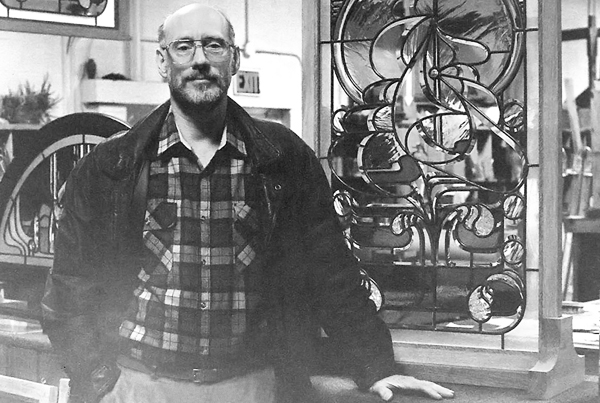
Ray Gregory, Art Glass, stained glass, Norfolk, Virginia
Thanks to all who helped along the way:
000000
|
Lyn Walker
Chuck Chamness
Keith Hicks
Jeff Whelan
Russel Harris |
Lee Daniels
Georgette Constant
Liz Witkowski
John Goodell
David, James, and Linda
|
|
|